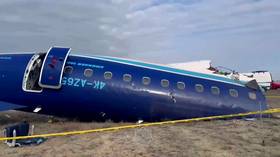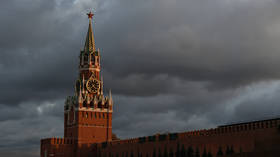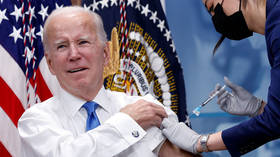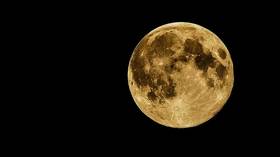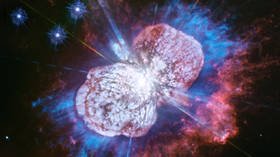Japanese probe makes final touchdown on distant asteroid to peek into solar system’s origins
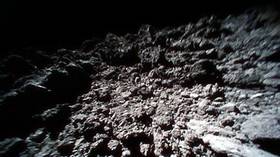
Japan’s Hayabusa2 probe has touched down on the far-off Ryugu asteroid, returning to the rock’s surface to collect more samples on a mission to learn about the birth of the solar system 4.6 billion years ago.
“The probe appears to have touched down successfully” according to Doppler data received by the control room, Japanese Space Exploration Agency (JAXA) spokesman Takayuki Tomobe told Japan Times on Thursday, adding that because Doppler only provides speed and altitude a definitive confirmation of Hayabusa2’s touchdown would have to come later in the day.
[PPTD] This navigation image was received on July 11 at 06:56 JST. pic.twitter.com/GegZX1RuSP
— HAYABUSA2@JAXA (@haya2e_jaxa) July 10, 2019
Hayabusa2 fired an “impactor” at Ryugu’s surface in April in preparation for this touchdown, creating a crater in order to expose layers of the rock that were previously hidden. The probe is expected to briefly land about 20m away from the center of that crater in order to collect samples of whatever materials were ejected from the impact three months ago.
Also on rt.com Japanese probe BOMBS ancient asteroid to look inside it“It would be safe to say that extremely attractive materials are near the crater,” Hayabusa2 project manager Yuichi Tsuda said. A photo taken by the probe’s camera shows that parts of Ryugu’s surface in and around the crater are covered with “obviously different” materials from the rest of the surface.
Elsewhere in the solar system right now, the #Hayabusa2#spacecraft is touching down on the #asteroid#Ryugu.Watch the excitement unfold at https://t.co/WuQlEBKtZ0 and discover what UTokyo researchers hope to find.https://t.co/OsruiOAx5P#space#life#water#utokyoresearch
— UTokyo | 東京大学 (@UTokyo_News_en) July 11, 2019
Hayabusa2 has been busy on and around Ryugu, collecting samples during its earlier touchdown in February by firing a smaller bullet-like projectile at the asteroid’s surface in order to sample the tiny fragments of material dislodged by the impact. The probe has also landed a handful of tiny rovers on the rock’s surface.
The probe’s mission is drawing to an end, however – the touchdown is the last “major” component, and Hayabusa2 will return to Earth next year, allowing scientists to analyze the materials collected. Their hope is that the samples provide a window into what the solar system was like at its birth – or clues to how life first developed.
“I’m really looking forward to analyzing these materials,” mission manager Makoto Yoshikawa said.
Like this story? Share it with a friend!


